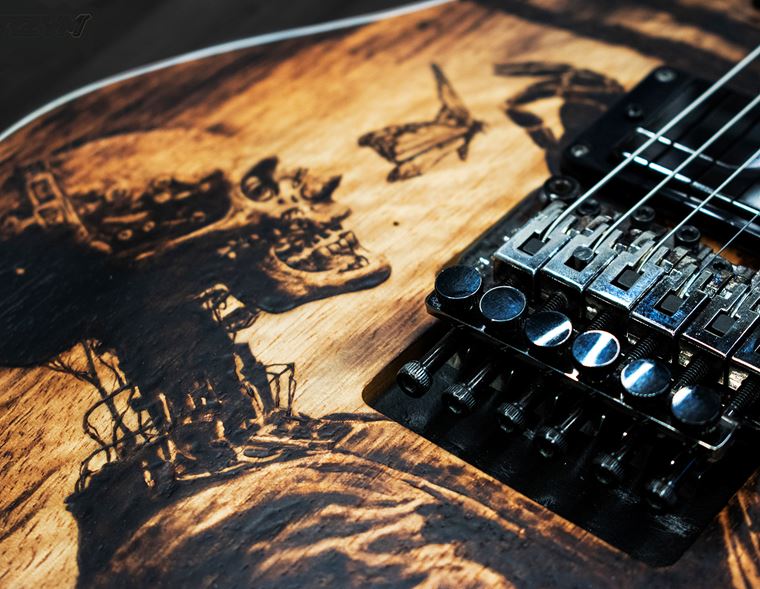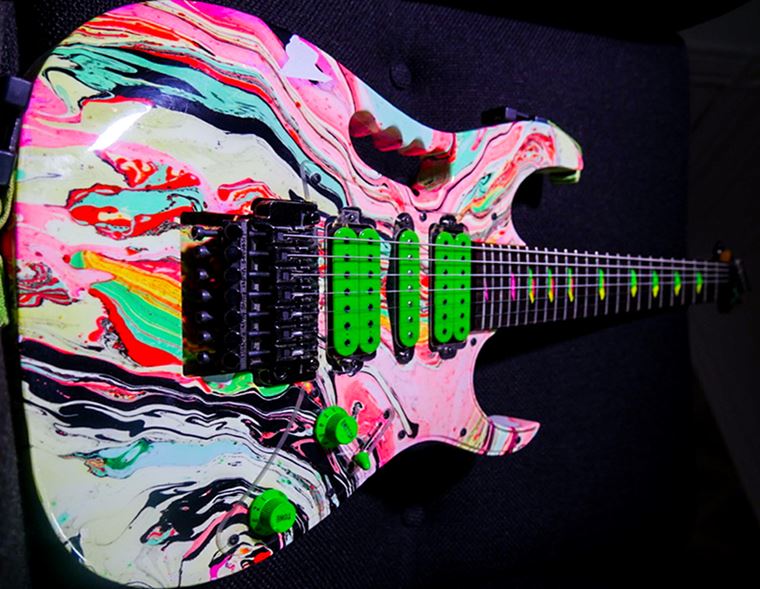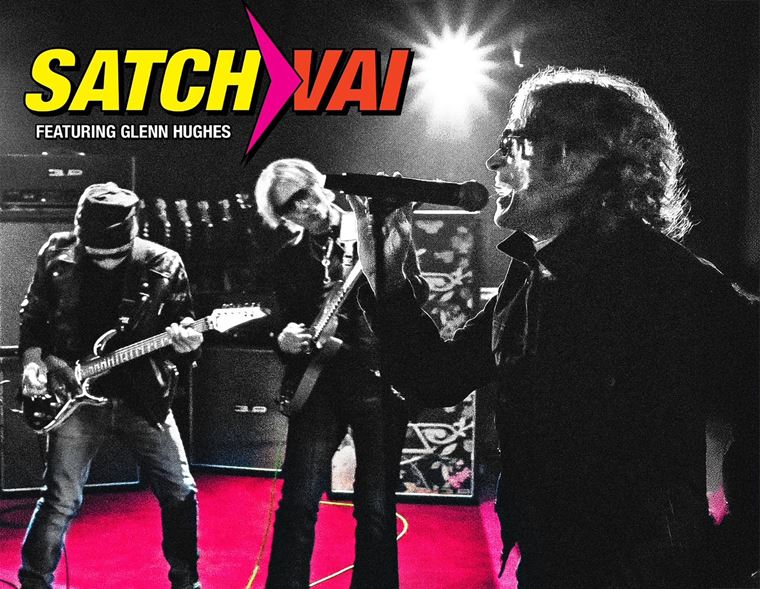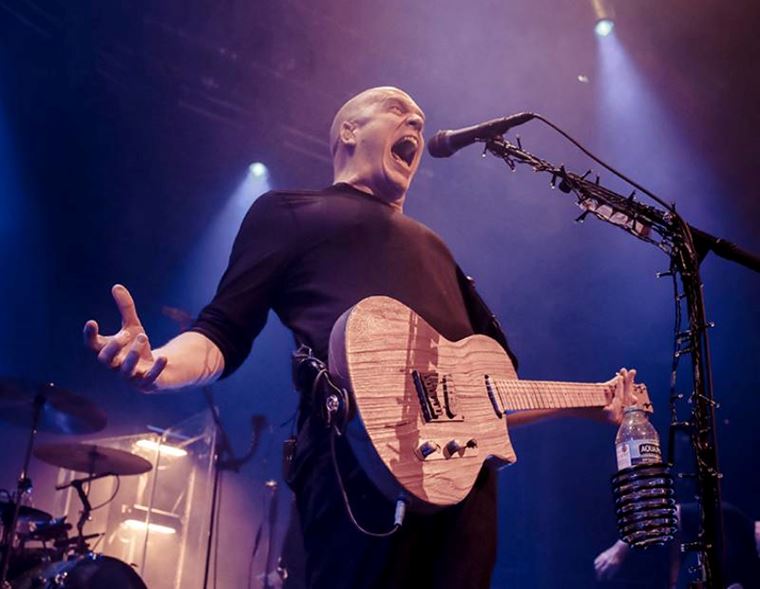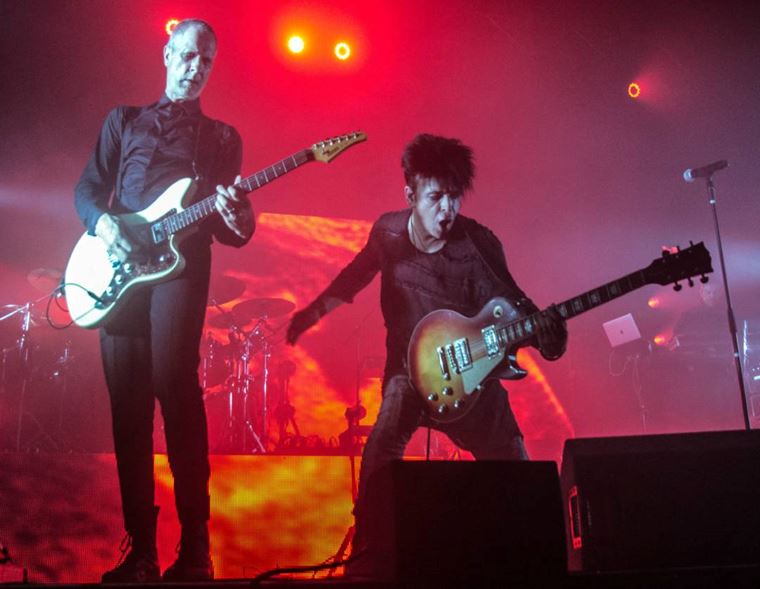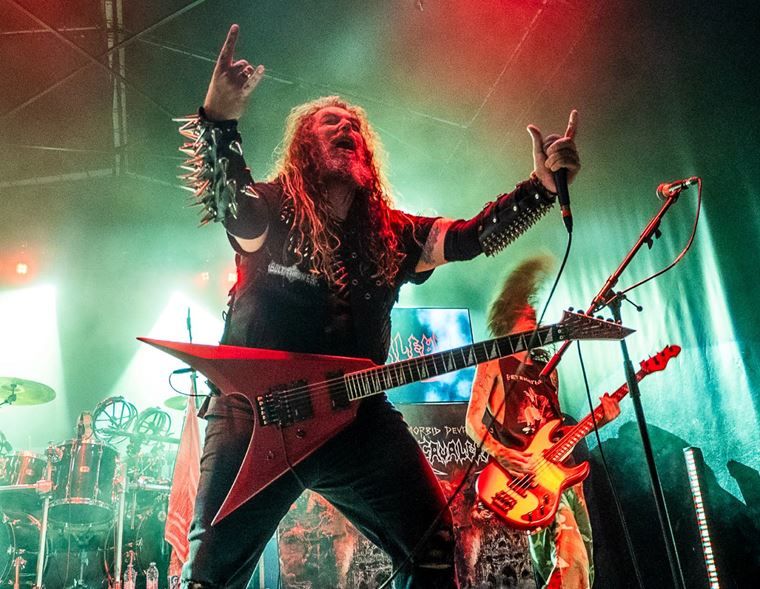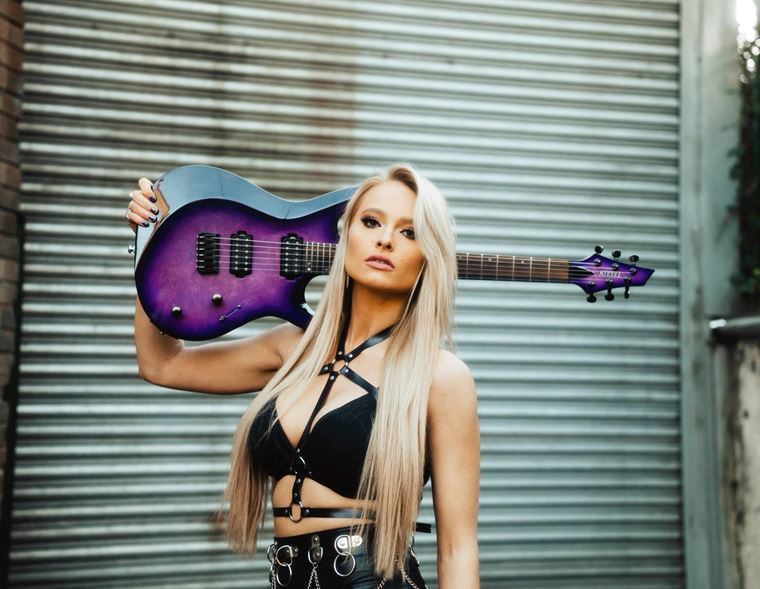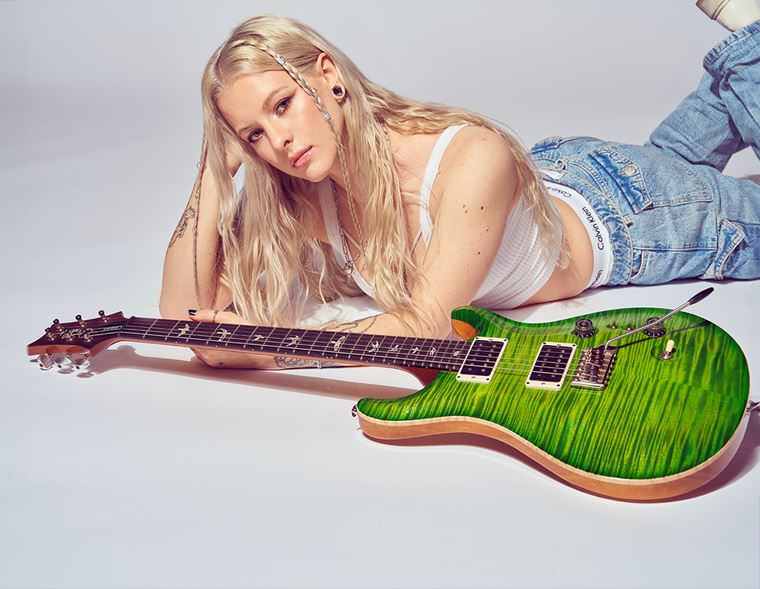Todd Rundgren Interview
Todd Rundgren is an ideas man.
The singer-songwriter-multi-instrumentalist is also a celebrated producer (Bat Out of Hell, anyone?!), a creative, unpredictable musical powerhouse and a developer of many concepts that have since gone on to shape much of our modern lives.
 copy.jpg)
(Photo: Lynn Goldsmith)
Sound like too much on our part? Well, consider this: Todd designed the very first graphics tablet for Apple way back in 1979! He also pioneered downloadable music in 1992, when most people didn’t even know what the internet was! Todd was ahead of platforms like Patreon when he invited fans to subscribe to his site in order to enjoy perks like behind the scenes access to Todd in the studio, for example. Sound familiar? He did that decades ago! Other innovations like full-length gigs filmed in 360 degrees are his, too.
Todd Rundgren is one impressive guy.
Given that he is a man of forward-thinking resolve, it would seem appropriate to look to him for ideas on how to handle a tour during this current, difficult climate, wouldn’t it?
As ever, Todd hasn’t disappointed us! This year sees him and his band embark on the Clearly Human tour, which is almost in no way a ‘regular’ music tour. Indeed, Todd is performing to 25 different US cities, but he’ll be staying in Chicago for every performance. Yes, Todd Rundgren has now invented the virtual tour, and if it’s a success, it could be a viable way for all musicians to not only perform safely and efficiently, but also to help address climate change.
So how does it work? Well, the initial plan, which, as we’ll learn later, has now somewhat changed, was to use ‘geo-fencing’ for every date on the tour. For instance, if the band were broadcasting to St Louis, only those within the St Louis IP address catchment would be able to see the show. That way, each gig would be more ‘local’, and the production would reflect that in various cool ways, as we’ll also hear soon!
People who live outside the overall geo-fenced zone (i.e. those outside of the US and so on) can buy a ticket to any of the shows and enjoy it. Fans can also buy bundles of tickets to see multiple shows, and each night will be different due to the ‘localising’ that we’ll hear about. It’s a pretty fun, exciting concept for sure. We’ll let Todd fill you in on the details himself, since he was kind enough to jump in front of his computer from his home in Hawaii and chat to us about it!
Todd was lovely company: warm, friendly and engaging. We discussed this upcoming tour, how it might be for both the audience and the band. We talked guitars, he shared advice on publishing, and yes, we got some fun chat in about Todd’s production work on Bat Out of Hell! Read on, for the full lowdown!
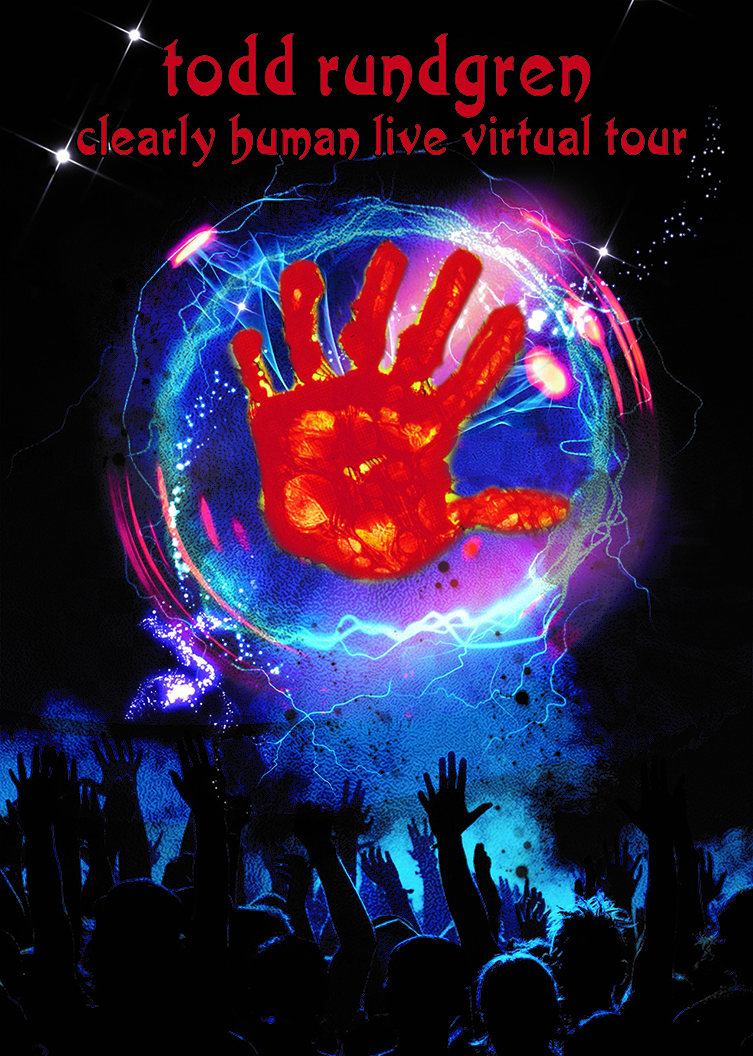
Todd Rundgren Interview
guitarguitar: Hi Todd, how are you? All good?
Todd Rundgren: Yeah! I’m a little antsy, but otherwise we’re fine here! I’ve just been in the same geographical location a little too long.
GG: Yeah, I can attest to that. So, I’m looking forward to hearing all about the new tour! It’s an incredible concept, and one that could really change things for musicians, particularly in this current climate.
TR: Well, I actually got the idea for a virtual tour a couple of years ago when I found myself, for the umpteenth time, sitting in the airport waiting for a flight that was delayed or might never come at all. Panicking, trying to find new connections to get to the gig, and I found this ever more commonplace. It’s because of climate change, the weather getting worse and shutting airports down and then that ricocheting through the entire system. So, I’d figured that, well, the weather’s not suddenly just gonna get better again, you know? Last summer we had the state of California on fire, and the state of Texas under water, so it doesn’t matter how you wanted to tour, you’d run into climate-related issues! So, the idea of virtual touring started to germinate then.
"I would say my advice is the same thing you would do if you were a professor: publish, publish, publish!"
But of course, the latest developments... I hadn’t factored in the idea that the audience couldn’t make it to the gig (laughs), so I suddenly realised that instead of doing like I’d originally imagined: that we’d set up in a performance space and do the show like we normally would, but would be broadcast to a venue somewhere with a video screen. That would mean that I couldn’t get there but the audience could. Now, the audience can’t get to that place with the videoscreen. They have to stay at home. So, that pretty much put the nail in that coffin! (laughs) I had to figure out a way to do this, and not simply narrowcasting to a venue but accommodating all of the various factors that go into trying to recreate a live experience when everybody is actually remote.
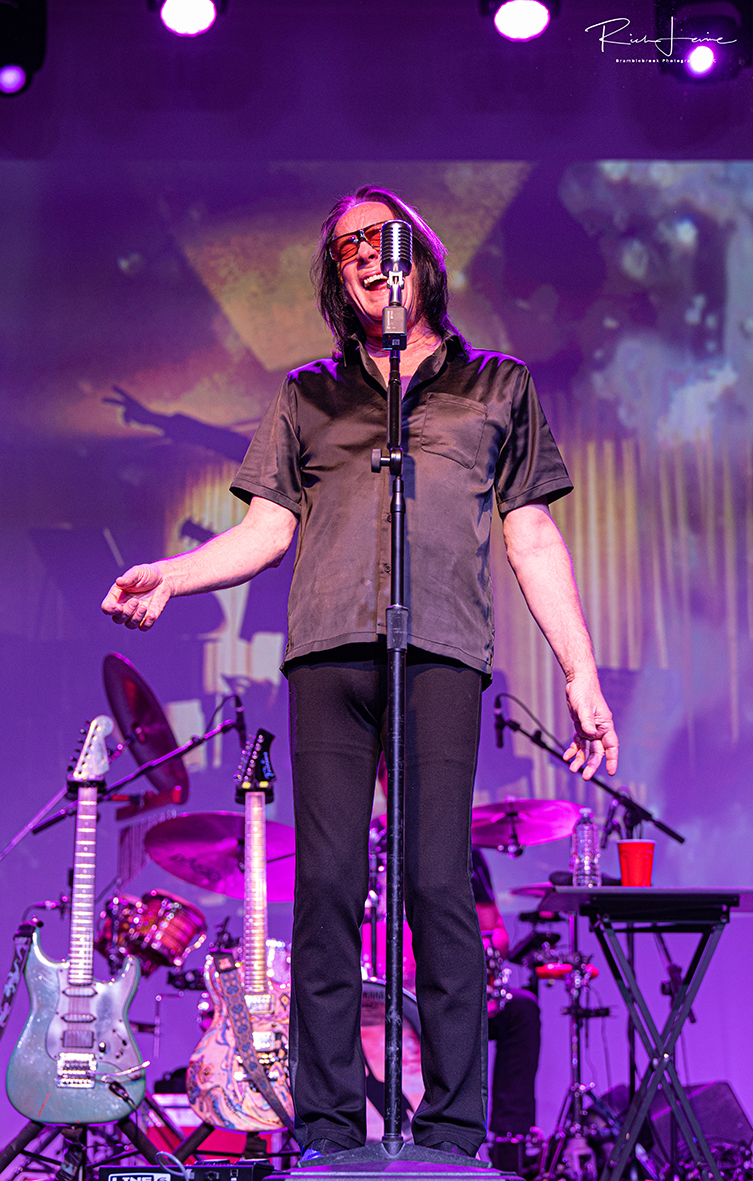
(Photo: Rich Levine)
GG: Something like this has never really been attempted before. So, you’re staying in Chicago for the 25 shows, and people outside of the geo-fences can watch all the shows, right? This has world-wide potential, hasn’t it?
TR: Well actually, we have sort of refined the geo-fencing model. At first we thought that this was a great way to kind of emphasise the local nature of the shows, so that we would know we were broadcasting to an audience of a particular town or region. As it turned out, there would be situations where somebody who wouldn’t be living in the city the show was in, they’d be living in a suburb and could probably drive to the venue in 20 minutes, but for some reason, the geo-fencing wouldn't let them get into the show!
GG: Ah!
TR: Yeah, it’s the fact that anything outside a range of IP addresses can’t hook up. We suddenly realised that that was kind of upside down: the only reason why we were doing it was because there are certain territories I can’t play because I’ve agreed to do a regular tour later in the year. So, we’ve changed it so that when there’s a show in a particular area, yeah, it’s blocked out, but in reality, anybody can go to pretty much any show they want! (laughs)
"When I first started playing guitar, I was just mental about it, you know? And has time has gone on, I realise that my commitment is to music in general."
So the real difference is, we’re putting extra emphasis on the local nature of these shows. Each one is targeted for a particular city and, most often, they are cities that we’ve been to before. We have familiarity with them, we recognise fans from those cities who come to the shows. If you have time off, there’s things you like to do there, walks you like to take, landmarks you might visit, restaurants you like to eat at... So, a lot of that’s still already built in for the audience but for us, being in one location, we have to go some extra effort to sort of self-hypnotise! Y’know, wake up every morning, go to the venue and say, ‘I’m in Kansas City now!’ (laughs) or ‘I’m in Orlando, Florida now!’ We’ll do everything we can to kinda reinforce that, like: the backstage will be all festooned with memorabilia and posters, sports teams, and we’re going to keep the clocks all at the local time of the virtual venue that we’ll be playing. And we’ll try – we’re still working on this, it’s pretty complicated – but we’re gonna try to get from every town some signature eatery to send us food from that town, so that we’re eating the same food that people could order to their house!
GG: That is such a cool idea!
TR: We’ll have like a live YouTube channel, or a live Facebook channel or something like that of all of the activities going on backstage and the catering will be one of them. Everyone will be able to see that we’re eating Buffalo wings when we’re in Buffalo. (laughs)
GG: That’s awesome! And in terms of the setlist and so on, I know you’re going to be performing Nearly Human in its entirety, but you’ve got hundreds and hundreds of songs! How do you choose a setlist? Or are you changing them up night after night?
TR: Well, even playing the lion’s share of Nearly Human, that’s less than an hour and we do a two-hour show, normally, so obviously we have to be drawing from other material. We’re gonna draw from the album that was immediately after that, called Second Wind, because it was kind of the same line-up and it was recorded in the same way: we recorded everything live. So that all fits together somewhat seamlessly. And yeah, various tunes from various parts of the oeuvre, some later...Nearly Human was over thirty years ago, so there’s a lot of music between then and now as well. Most of what we choose will stick with the flavour of Nearly Human, which is an R’n’B/Gospel-inspired record, mostly. Yeah, we have some danceable material, heheh!
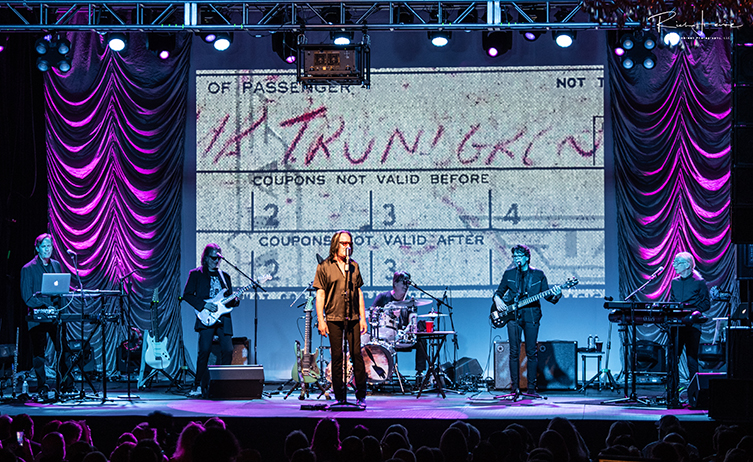
(Photo: Rich Levine)
GG: Haha, so thinking about that, normally when you play danceable material, there would be an audience dancing! Now it’s gonna be a whole different thing! I read somewhere that there might be a virtual audience? And that there might be the chance for a few socially-distanced ‘actual’ people to be there too, is that correct?
TR: Yeah! It’s become a more familiar site on certain TV programs like the NBA, they’ve been doing this for a while: they put video panels in the seats and then people’s heads will appear on them, just as if they were there. So, we’re doing a similar thing: we’ll have the first three rows be a mixture of video panels and people can buy essentially a seat in one of the front rows so we can see them as well as then seeing us! We can mug to them and wave to them (laughs). Then, to whatever degree we’re allowed to have actual bodies in there, we’ll be supplementing that with real people. So, we’ll get the immediate reaction of the people who are actually physically there, and then we’ll get the ever-so-slightly delayed reaction (laughs) from the people who are in various parts of the country or the world.
"We’d come back with, like, half a dozen guitars every time we’d go to Japan! One of them was this Seafoam green guitar that I now call ‘Foamy’"
GG: Yeah! It’s very, very strange! It’s a very futuristic way of doing it, but then that’s part of being a pioneer, I suppose, isn’t it?
TR: Um, well, we’ve got a lot to learn! As a matter of fact, we’re learning that the whole dynamic of promoting it & marketing it is completely different from when you’re doing a physical tour. People know, when you’re doing a physical tour, that there’s only so many seats, y’know? So everyone rushes out right away to get their favourite seats for the show. But everyone realises that, for a virtual show, there isn’t the same dynamic, so everyone waits as long as possible, which is really scary! (laughs) Most of the time, you hope to have most of your gigs sold to the guarantee point, which is usually two thirds of the house. You’re hoping that everyone makes money and you sell at least two thirds of the house, but since there’s no physical limitation – we don’t know how big or how small the virtual venue is, you know? – if only a few people from a certain locality are in the mood to go to the show, then it’s like playing a small club. And then you go to another place where a whole lotta people wanna go and it’s like playing a small arena! So, we have to kind of transcend that in our minds, not think about how many people exactly are listening in any particular point in time and imagine ourselves in probably about a 1500 seat proscenium theatre.
GG: Okay.
TR: Which is the ideal environment for this kind of show. Somewhere between 1200 and 3000 people.
GG: Brilliant. That's a good audience size for your to 'project' as you play! Now, let’s talk guitars! What will you be taking ‘on the road’ to Chicago with you?
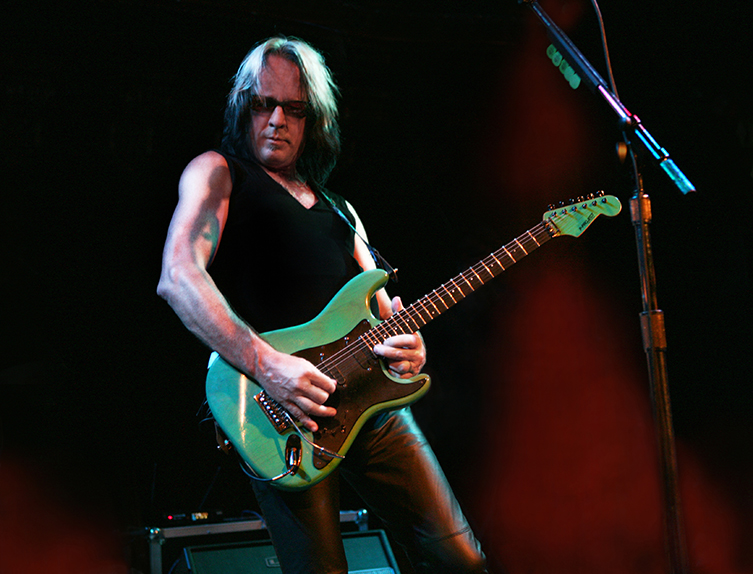
TR: Well, I’ve been playing this Seafoam Green hybrid. The headstock says P-Project, made by Fernandes, who was actually a Japanese manufacturer who was licensed by Fender to make Fender-style guitars for the Japanese market. Actually, back when we were first doing Nearly Human, we had tour support, so we could afford to go to other parts of the world with the 11-piece band. We went to Japan, and in those days, Japan was doing really well economically, you know, and the US was doing much less well economically, so anything from the US was a bargain in Japan! That’s why we could afford to go there: they would pay top dollar for American acts to come and do tours in big venues.
When you went there, people from electronics companies, and people from musical instrument companies would show up at all the gigs and bring their stuff with them, to just give you. It was like promotion, you know: ‘take a picture with it, and it’s yours!’
GG: Not bad!
TR: We’d come back with, like, half a dozen guitars every time we’d go to Japan! (laughs) One of them was this guitar that I now call ‘Foamy’. They all piled up in a warehouse for a while and I decided that I’d go through ‘em and pick one out. It turned out to be the best sounding and most playable one. I’ve been playing that one pretty much exclusively ever since.
"Steinman said, ‘What’s the highest note you can hit, Meat?’ and Meat would struggle to hit it, and Steinman would say, ‘Okay, that’s where the song starts!’"
GG: Wow! Obviously, you’re a very talented and discerning guitarist. What is it about that particular guitar? Why do you like it over the others?
TR: Well, it had a combination of the things that I liked. I started out, like, strictly Eric Clapton, you know? When I first started playing guitars seriously, I wanted to be Eric Clapton. I only wanted to play SGs and Les Pauls, stuff like that. Jimi Hendrix was the one with the weird sounds and the wangle bar and stuff. But, as time went on, I kinda hit a wall with imitating Eric Clapton. I said, ‘Okay, let’s move beyond this’, and I started playing more Fender-style guitars, or guitars with tremolo bars on it. For a while I played Fender Mustangs.
GG: Ah, ok.
TR: Indeed, that’s the guitar I used on Bat Out of Hell to get the motorcycle sounds and stuff. The reason why it worked well for me, even though it was very difficult to play on the higher frets – because it’s a student guitar, it’s a shorter scale – but what you could do with the whammy bar was unbelievable, you know? It was way further than any other guitar. You’d push all the way down and the strings are actually sagging, they’re drooping (laughs), you know? And then you’d get these ridiculously screamy harmonic notes when you pull it up. So, for a while I used to play with that. I didn’t have a whole lot of allegiance to any particular guitar, I’d use whatever was appropriate to the gig. By the time I wound up playing with Ringo (Starr) the past decade, I was playing acoustic guitar more than anything! Which is not really my strong point, but I would be playing as much acoustic guitar as electric. Most of the time, I would only be soloing on my own stuff, because Steve Lukather was the other guitar player, and Steve’s got solos for everything! (laughs)
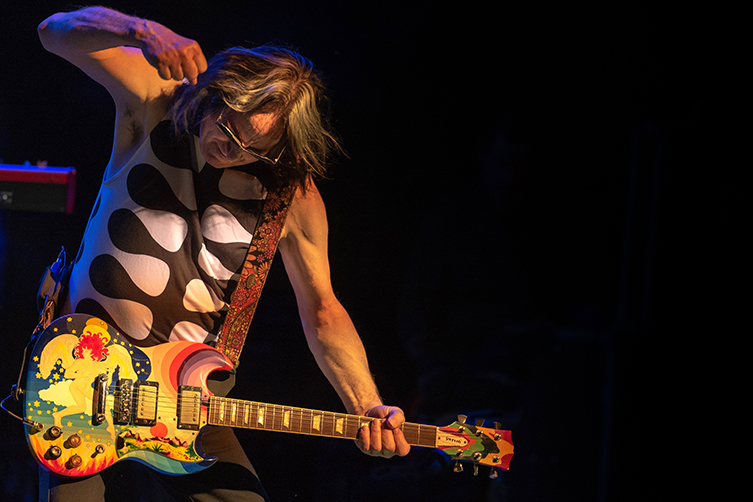
(Photo: Richard Kerris)
GG: You’ve played some very unusual, unorthdox guitars over the years, from the Backlund to Clapton’s famous ‘The Fool’ SG. Do you still own that one on your collection?
TR: I don’t have the original anymore. I do have a fairly dead-on clone of it that I got back in the 80s. Again, I was in Japan and some Japanese guy went and found the original model year of the guitar, painted it from pictures he had found in a magazine, and gifted me the guitar.
GG: Nice!
TR: And actually, it sounded better than the Fool guitar because the pickup set were the original pickup set. They hadn’t been, like, unwound. I think Eric unwound the pickups to give it a sharper sound. It just had a richer sound, so I tended to play that more than the other one. Then, in the mid 90s I got in trouble with the IRS, so I auctioned off Eric’s old guitar! (laughs) But I still have the clone and I guess the last time I played it was, uh, a tribute to the White album with Joey Molland from Bad Finger and Christopher Cross and a bunch of other people. That’s the last time I played that guitar.
GG: Sounds like a good show! Now, given that you’re very well known as an innovative ideas man and a thinker, I wondered: as a guitarist, is there anything about the instrument that you feel could be improved?
TR: Well, I’m not the guitar player I used to be, put it that way! When I first started playing guitar, I was just mental about it, you know? Nearly suicidal! And as time has gone on, I realise that my commitment is to music in general, it isn’t just to that particular instrument. There was a time when I was doing almost all of my songwriting on the piano and I had to be self-conscious and say, ‘Okay, I’m gonna do a guitar record now!’, haha!
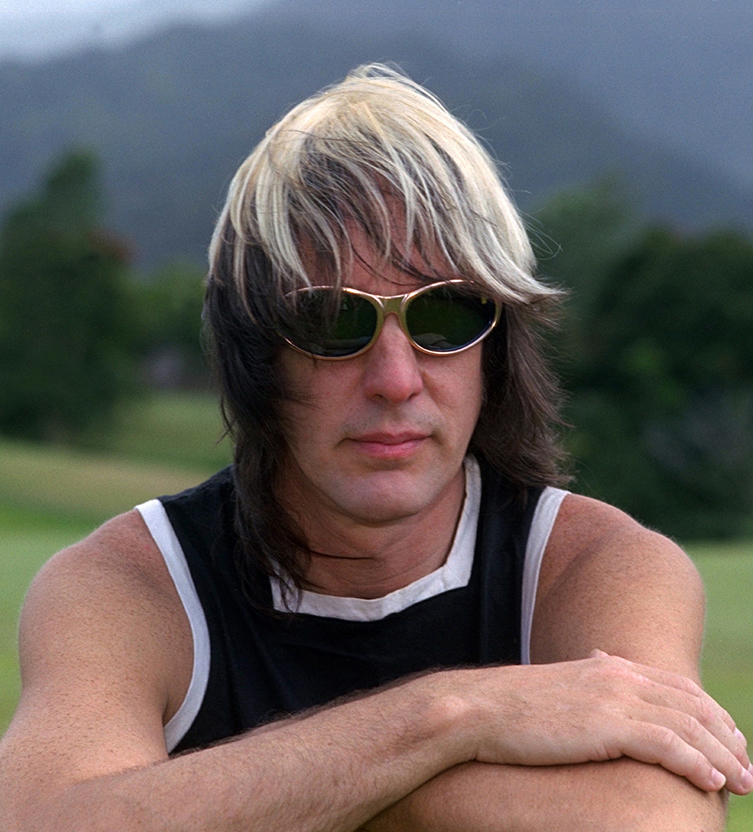
(Photo: Danny O'Connor)
I think that we’re in a great place now, in terms of the affordability of music. There are instruments for every budget and they’re all pretty well made, nowadays. Me, the last innovation that I completely adopted, I guess, was modelling because I’ve taken to using no – or as little as possible – live amplification on the stage. It often turns into a contest of who can be the loudest! I haven’t had an amplifier on stage for many, many tours now. I put my guitar in the side-fills and that’s all I need. So, I’ve been using emulation for a while, starting with the Line 6 stuff, which I still use on occasion. I can’t remember what my latest thing is because it’s been a year! (laughs)
GG: Haha, fair enough! Well, I’ve only got two more questions, if that’s okay? One of them is kinda of an obvious one, but since you mentioned Bat Out of Hell...you were the producer of that record, which is an incredible thing to be able to say! I just wondered what it was like working between two such large personalities as Jim Steinman and Meatloaf? How do you 'be' that third guy in the room?
TR: Well, it was a pretty well-defined relationship that existed before I got involved in it. Steinman was the Svengali: he came up with all the ideas and stuff like that. As a matter of fact, he had the ideas before he met Meatloaf, and he was looking for someone who had a grandiose personality, who could help realise those ideas. So, the roles were pretty strictly defined. Meatloaf didn’t do any of the writing. He maybe made a few suggestions, or something like that, but for the most part, all written by Steinman.
And y’know, Meatloaf’s biggest challenge was to hit the highest notes that he possibly could! (laughs) Cuz that’s the way Steinman wrote: he said, ‘What’s the highest note you can hit, Meat?’ and Meat would struggle to hit it, and Steinman would say, ‘Okay, that’s where the song starts!’, you know? (laughs) And then everything comes down from there! So, Steinman would kind of establish a destination which was that highest possible note, and the songs would always be heading towards that! Meatloaf, he was already a fully realised personality: he’d been on Broadway, the Rocky Horror Show, so he was used to being that big personality and he pretty much focussed on that role. It was a challenge for him to sing that record, and it was a big enough responsibility just to focus on that, you know?
GG: Yeah.
TR: Me, I was just kind of like...I was mostly responsible for realising Steinman’s vision, which was something very grandiose., and had some very specific elements in it. It wasn’t so much accommodating Meat – he was already there- he’d been singing the stuff live and in demo situations for years already (laughs), so it was simply a question of getting him to sing it in tune. Yeah, and that was pretty much it! That was the beginning of a long relationship with Steinman, not as much Meatloaf, but I did many, many records with Steinman after that.
GG: Amazing. Amazing! And one final question, Todd, if that’s okay? You’re a man who seems to have been very much in charge of your own career and your own pathway. In these increasingly difficult times for musicians, especially for those who want to make it their full-time income, what advice would you have for those looking to strike out on their own?
TR: Well, you know, somebody starting out at this point is 50 years younger than I am (laughs), so why knows where the industry is gonna be at in 50 years? I can’t predict that for any one person. I have to say though, the key to my survival nowadays is a combination of continuing to play as much as I can, being involved in everything I can and collaborating as much as I can, in order to keep my audience and to expand that audience if possible.
"I was mostly responsible for realising Steinman’s vision, which was something very grandiose., and had some very specific elements in it. It wasn’t so much accommodating Meat – he was already there."
But there’s this little thing, I dunno whether it works in other parts of the world, but it’s called reversion. It used to be that if you recorded an album for a label, they owned it for life. You know? Or if you had your songs published by somebody, they owned those, and controlled those songs for life. US congress established new rules in which after 30 or 35 years, you have the opportunity to reclaim that stuff.
GG: Right.
TR: What usually happens is you’d go to the label or the publisher who’s got the rights, and if they think it’s still worth anything, they’ll say, ‘Let us keep it, and we’ll give you a big advance. And, we’ll wipe out any of the old, outstanding advances that you had. So, in the past year, I’ve gotten 6 and 7 figure deals for stuff that was recorded 35 years ago! It’s suddenly secured my retirement! So, I would say my advice is the same thing you would do if you were a professor: publish, publish, publish! Make as much music as you can, record it and get it out there. If you can get somebody to distribute it for you, do that! But create content, create as much content as you possibly can. If some of it’s crap, it’ll disappear anyway, but if it’s good it’ll last, and maybe 30 years from now, you’ll get a cheque in the mail.
What a great person to have a conversation with! We certainly never pictured him going nuts on a Mustang for that famous ‘motorcycle solo’! We wish Todd and his band all the very best as they set out on their boundary pushing, Brave New World of touring. They are making history, and if you join them online, you can be a part of it, too:
We’d like to thank Todd for giving us his time and being so open with his answers. We’d also like to thank Peter Noble for putting us in touch. Thanks for reading and be sure to check out our other interviews over on the guitarguitar interviews page of our site.



